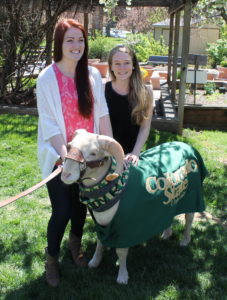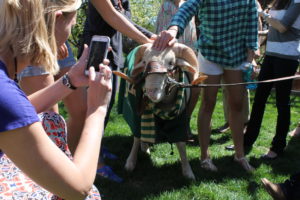[masterslider id=”151″]
It’s official: Visits with four-legged CSU mascot CAM the Ram are therapeutic.
In what may be the best show-and-tell of the year, two occupational therapy students capped off a presentation about animal-assisted therapy this week by bringing the real CAM the Ram to class.

Actually, the May 3 visit with CAM 25 occurred outside class, in the Occupational Therapy Garden, where the Rambouillet sheep posed for photos with OT students and faculty between nibbles of the irresistible, fresh grass at his hooves.
First-year OT students Stacy Langton and Tina Swearinger arranged the CAM appearance to follow their 30-minute class presentation on “farm-based interventions” and other types of animal-assisted therapy in OT 630, “Occupational Performance: Adult to Old Age 1,” taught by Assistant Professor Lisa Fyffe.
The two students discussed research showing that visits with pets and farm animals have a positive impact on people with mental disorders, autism, dementia, chronic diseases and neurological disorders. Langton and Swearinger said doing animal-related chores on a farm has been shown to boost self-efficacy, coping skills, self-awareness, self-acceptance, physical wellbeing and overall mood.
 While more sound research is needed on why animal-assisted therapies work, they said, an increasing number of practitioners have adopted the approach over the past several decades.
While more sound research is needed on why animal-assisted therapies work, they said, an increasing number of practitioners have adopted the approach over the past several decades.
After their presentation, Langton and Swearinger showed the class the video of CAM singing Adele’s “Hello,” a spoof produced by CSU’s social media team over winter break. Then much of the OT Building emptied when CAM and his Ram Handlers pulled up in their trailer and made their way to the garden.
Between photo ops, Langton and Swearinger presented CAM with a scarf bearing the words “CSU OT Honorary Therapy Ram.”
While CAM has not yet received the required certification to be used for animal-assisted therapy, the smiles on the students’ faces were clear evidence of the positive effects animals can have on people.
And the visit was bound to have a positive effect on Langton and Swearinger’s grade.